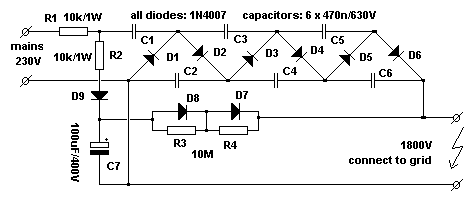 2-Stage bug zapper:
2-Stage bug zapper:

let's fry those bastards
 2-Stage bug zapper:
2-Stage bug zapper:

let's fry those bastards
Introduction
As most people, I do not like bugs in my home, so I bought an electric bug trap with a blue lamp and an electric grid to electrocute the bugs.
I installed the thing, but it did not work at all; the gnats remained! So I checked the dish: no corpses!
Time for some improvements! I opened the bug trap, it worked as follows:
A 100nF/630V capacitor is charged to about 600 Volts by a charge pump
built with two diodes and two 47 nF capacitors.
This "high" voltage is connected to the grid.
When a bug passes though the grid, it will short ciruit the 100nF capacitor and should be killed by electrocution
In practice 600V proves to be too low for many bugs! I checked this with some gnats I catched:
they just passed though the grid without any problem!
I measured the grid voltage, it did not even change when a gnat touches the grid!
Clearly 600V is too low to penetrate the external shield of the bugs.
The solution
My first thought was: higher voltage higher voltage higher.kill.... kill.. So I increased the grid voltage with a
diode/capacitor cascade and found out that the maximum was about 4kV - 10kV (depending on weather conditions).
This was already quite an improvement, I catched some unfortunate guinea pig-gnats: all were zapped, but still some survived!
Now it is time for the ultimate solution: the problem is the limited amount of energy
stored in a high voltage capacitor:
E= � * C * V�: so 5 kV in a 10nF capacitor will give you 125mJ only!
Eletrolytic capacitors from TV sets or photo flashers are better fit for energy storage: 100uF/300V gives 4500 mJ!
In the schematic below, the best of both capacitor types is used: A high voltage capacitor is charged
to about 1800V (which proved to be sufficient to penetrate the external shield of the bugs)
A large electrolytic capacitor from the flash unit of an old photo camera is used for energy storage.
2-stage bug zapper schematic:

The bug will be fried instantly by the 4.5 Joules from the elcap (this is enough to heat 1 cc water by 1.6 C)
This bug zapper works for anything which can pass though the grid. Even wasps (tough suckers) do not survive
By the way, the sound of the discharge is quite impressive............
Tip: do not bother to search the dish for bug-corpses; just sweep up the body parts scattered on the flour below